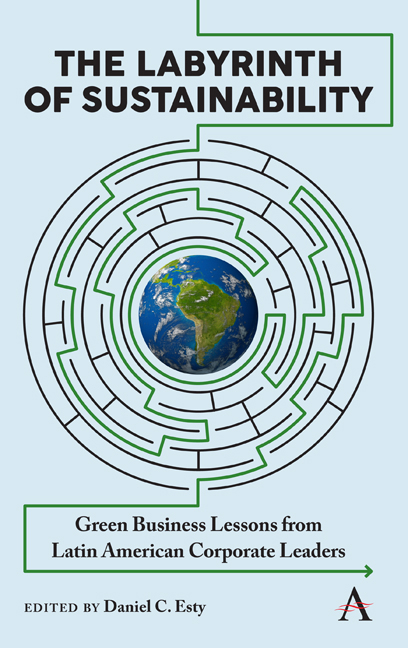Book contents
- Frontmatter
- Dedication
- Contents
- List of Illustrations
- Acknowledgments
- Notes on Contributors
- Introduction
- Chapter 1 Water Conservation in Scarcity Conditions: Corporate Sustainability at Mexico's FEMSA Group
- Chapter 2 Walmart Mexico: Clean Energy to Reduce Costs and Improve Corporate Image
- Chapter 3 Grupo Vanguardia Revitalizes Plastics Recycling in Honduras
- Chapter 4 Nissan Mexicana's Renewable Power Partnership
- Chapter 5 Tecnosol Follows the Sun
- Chapter 6 Rizek Pushes the Dominican Republic Cocoa Industry toward Sustainability
- Chapter 7 Centrosur Leads the Way to Sustainability in Ecuador
- Chapter 8 A Resilient World: Bavaria Builds Its Case on Water
- Chapter 9 Grupo Herdez Takes the Initiative in Mexico's Food Market
- Chapter 10 Chile's Las Palmas Avocado Orchard: Water Consumption Reduction in Agriculture
- Chapter 11 Mabesa: Increasing Global Competitiveness with Eco-friendly Disposable Products
- Chapter 12 Water Use Efficiency Initiatives in Nestlé's Value Chain and the Implications of the Company's Business Model
- Notes
- Index
Chapter 4 - Nissan Mexicana's Renewable Power Partnership
Published online by Cambridge University Press: 29 May 2019
- Frontmatter
- Dedication
- Contents
- List of Illustrations
- Acknowledgments
- Notes on Contributors
- Introduction
- Chapter 1 Water Conservation in Scarcity Conditions: Corporate Sustainability at Mexico's FEMSA Group
- Chapter 2 Walmart Mexico: Clean Energy to Reduce Costs and Improve Corporate Image
- Chapter 3 Grupo Vanguardia Revitalizes Plastics Recycling in Honduras
- Chapter 4 Nissan Mexicana's Renewable Power Partnership
- Chapter 5 Tecnosol Follows the Sun
- Chapter 6 Rizek Pushes the Dominican Republic Cocoa Industry toward Sustainability
- Chapter 7 Centrosur Leads the Way to Sustainability in Ecuador
- Chapter 8 A Resilient World: Bavaria Builds Its Case on Water
- Chapter 9 Grupo Herdez Takes the Initiative in Mexico's Food Market
- Chapter 10 Chile's Las Palmas Avocado Orchard: Water Consumption Reduction in Agriculture
- Chapter 11 Mabesa: Increasing Global Competitiveness with Eco-friendly Disposable Products
- Chapter 12 Water Use Efficiency Initiatives in Nestlé's Value Chain and the Implications of the Company's Business Model
- Notes
- Index
Summary
Abstract
As part of its mission statement, Nissan Motor Corporation instituted the Nissan Green Program (NGP), a roadmap for making the Japanese automaker the worldwide leader in zero-emission mobility. In 2011, Nissan launched NGP 2016, the third iteration of its green program, focused on reducing its carbon footprint, shifting to renewable energy, and diversifying the resources the company uses. In keeping with NGP 2016, Nissan Mexicana— the company's Mexican subsidiary— took a risk by adopting renewable power for the largest of its three plants, located in Aguascalientes. Before 2012, the main source of electricity in Mexico was the government-backed Comisión Federal de Electricidad (CFE), which used mostly fossil fuels to produce power. Nissan's facility, known as Aguascalientes 1 (or A1), has been using electricity generated from biogas and wind since that time and, by 2014, obtained nearly half of its electricity from renewables. These renewable energy sources have saved Nissan Mexicana money, lowered greenhouse gas emissions, and bolstered the company's reputation. This chapter shows how Nissan Mexicana and its energy development partner, ENER-G, worked with municipal and state governments to match interests and enhance environmental sustainability.
Introduction
Climate change has deeply impacted the global automotive industry. For nearly a century, the industry's main product— four-wheeled transportation powered by fossil fuel combustion— has been a major emitter of greenhouse gases (GHGs). Now, however, the tables have turned. The socalled carbon constraints to limit climate change are present in all automotive markets. These rules require auto manufacturers in the United States, European Union, and Japan to lower the carbon emissions of new vehicles and develop new technologies to help meet constraints. For example, according to Nissan's 2012 sustainability report, Japan's 2009 Emission Standards require a 47 percent reduction in nitrous oxide and 64 percent reduction in particulate matter emissions from 2005 levels for many Japanese vehicles. Europe's 2015 “Euro 6” standard aims to reduce automotive emissions in graduated stages. All mass-produced automobiles and vans must now meet emissions standards for nitrogen oxide, carbon monoxide, hydrocarbons, and particulate matter.
Carbon constraints generate both risks and opportunities for manufacturers like Nissan. Though new rules may be forcing automakers to change their practices, companies that use carbon constraints to drive innovation are creating competitive advantages.
- Type
- Chapter
- Information
- The Labyrinth of SustainabilityGreen Business Lessons from Latin American Corporate Leaders, pp. 47 - 60Publisher: Anthem PressPrint publication year: 2019

